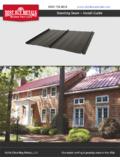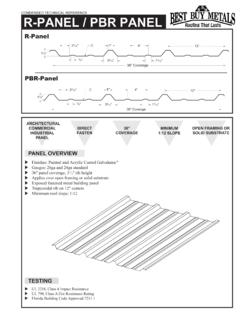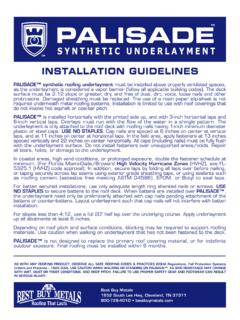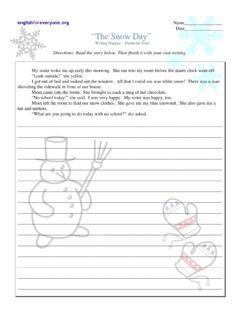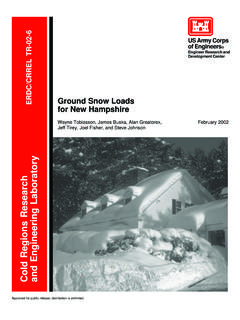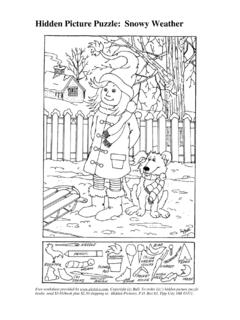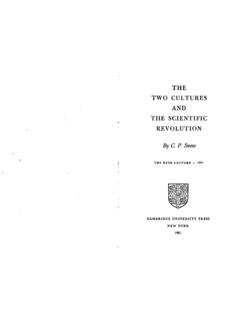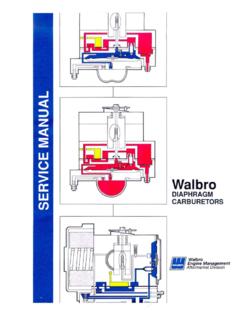Transcription of IX. Wind, Snow, Seismic and Rain Data by U.S. County
1 IX-1 Revised 11/02 IX. wind , Snow, Seismic and rain data by County Introduction In this section, climatological data are tabulated by County . The methods used to determine each of the values are given below. Using a single point to represent an entire County may produce substantial errors for counties with large areas or closely spaced load contours.
2 For example, in Alaska the large political divisions are not conducive to assigning a single value. The values given should only be used as a relative guide and the map should be referred to for the appropriate design parameters. Snow loads in some areas should be used with caution since local conditions may be more severe than indicated here. Also, some regions have very closely spaced contours that could introduce errors. Seismic spectral response values were obtained from County -by- County data provided by BSSC that were compiled from the 1997 standard.
3 Values were provided by zip code, but were taken at the County seat in order to obtain countywide values for the purpose of this compilation. For areas of high Seismic activity, this provides a very crude location measure and may yield significantly unconservative ground motion values. The recommended approach, in areas of high seismicity, is to use the CD provided with the IBC. Additionally, inputting the latitude and longitude of the site yields the most accurate spectral response values. The latitude and longitude can be readily obtained from the site street address from a source such as Ground snow loads are based on ASCE 7-98 Figure 7-1 (Table 7-1 for Alaska) and are also reproduced in IBC 2000 as Figure (Table for Alaska).
4 wind velocities are based on ASCE 7-98 Figure 6-1 that is also reproduced in IBC 2000 as Figure 1609. Note that counties that have all or part of their boundary in a "Special wind Region" are noted with an asterisk after the basic wind speed. Special consideration should be given to these regions where records or experience indicate that wind speeds are higher than those reflected in the ASCE or IBC figure or the County listing. For wind velocity, values were determined by linearly interpolating between the two contours on either side of a County using the approximate geographic center of the County .
5 Ground snow load was not interpolated, that is, the value of the snow load at the point chosen for the County was used. Counties that may have areas that fall in an IBC designated wind borne debris region are noted with the basic wind speed in bold type. These counties may include hurricane-prone regions which are within one mile of the coastal mean high water line and where the basic wind speed is 110 mph or greater; or where the basic wind speed is 120 mph or greater; or Hawaii. The design wind speeds used in these counties, that are generally in areas of closely spaced contours along the coastline, should also be closely evaluated based on where the actual building is located on the ASCE or IBC figures.
6 Rainfall intensities were determined somewhat differently. The contour maps found in the Weather Bureau Technical Paper No. 40 for thirty-minute duration storms with return periods of five and twenty-five years were used. The values of the contours were adjusted to reflect 5-minute duration by using the factor found in the paper. New contours with whole number values were drawn and each County was assigned the value of the next largest contour. Metal Building Systems Manual IX. Climatological data by County Revised 11/02 IX-2 LEGEND S : Ground snow load for 50-yr.
7 Mean recurrence interval in pounds per square foot (psf). ( ) Numbers in parentheses represent the upper elevation limit in feet for the ground snow load value given. Refer to ASCE 7-98 Figure 7-1 or IBC 2000 Figure for other ground snow loads that may be available for higher elevations. CS Indicates site-specific case study is required. W : 3-second gust wind speed for 50-yr. mean recurrence interval in miles per hour (mph). * Indicates part of the County is in a Special wind Region and may require special consideration or local knowledge of actual wind speeds.
8 Basic wind speeds in bold type indicate that the County may have areas that are designated as wind borne debris regions. Ss: Second spectral response acceleration (5% critical damping). 2% probability of exceedance in 50 years. S1: Second spectral response acceleration (5% critical damping). 2% probability of exceedance in 50 years. I1 : Rainfall Intensity (inches per hour). 5-minute duration 5-year recurrence Indicates rainfall intensity is undefined. I2 : Rainfall Intensity (inches per hour). 5-minute duration 25-year recurrence Indicates rainfall intensity is undefined.
9 IX. Climatological data by County Metal Building Systems Manual IX-3 Revised 11/02 S W Ss S1 I1 I2 County Name ALABAMA 5 96 8 11 Autauga 0 130 10 12 Baldwin 5
10 98 8 11 Barbour 5 92 8 11 Bibb 10 90 7 10 Blount 5 98 8 11 Bullock 5 104 9 11 Butler 5 90 8 10 Calhoun 5 92 8 11 Chambers 5 90 7 10 Cherokee 5 93 8 11 Chilton 5 103 9 11 Choctaw 5 105 9 11 Clarke 5 90 8 10 Clay 5
